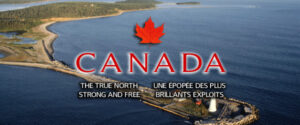
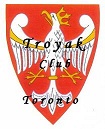
TROYAK EXECUTIVE TEAM is informing all members, colleagues, collectors, and Polonia at large, that Club meetings taking place at John Paul II Polish Cultural Centre, 4300 Cawthra Rd. (just south of Hwy. 403), Mississauga, Ontario. The new members are always welcome. www.polishculturalcentre.ca
ADRES SPOTKAÑ KLUBOWYCH ! Zarząd Główny Klubu “Troyak” informuje wszystkich członków kolekcjonerów, sympatyków oraz całą Polonię, że spotkania klubowe odbywają się w Polskim Centrum Kultury im. Jana Pawła II, przy 4300 Cawthra Rd. (na południe od autostrady 403), Mississauga, Ontario. Zapraszamy nowych członków do prężnego. Klubu “Troyak”. www.polishculturalcentre.ca

“TROYAK” CLUB NEXT MEETINGS …
NASTĘPNE SPOTKANIA KLUBU “TROYAK” …
Sunday 25th June 2023 @ 4:30 p.m.

July & August 2023 – Summer break … Letnie wakacje …

TROYAK CLUB @ Roncesvalles Polish Festival 2023
Saturday, September 16th & Sunday, September 17th, 2023
https://polishfestival.ca www.kazimierz.org
St. Casimir’s Church
Parish Hall … 156 Roncesvalles Ave. Toronto, Ontario
Stamp Exhibit … Pope John Paul II on World Stamps and
Displays of Coins, Stamps, Collectibles by Troyak Club Members.
Roncesvalles Polish Festival
www.troyakclub.com
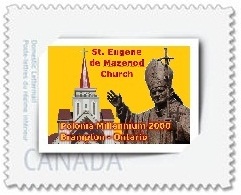
30th September 2023
29th October 2023
26th November 2023
Sunday – 3rd December 2023 @ 9:00 a.m. to 4:00 p.m.
Mississauga Coin & Stamp Show
December 2023 … Happy Holidays!


Stanisław Wojciechowski – drugi prezydent II RP
www.poczta-polska.pl
W dniu 4 kwietnia 2023 r. został wprowadzony do obiegu znaczek pocztowy o wartości 3,90 zł emisji “Stanisław Wojciechowski – drugi prezydent II RP”. Na znaczku przedstawiono wizerunek Stanisława Wojciechowskiego, na tle widoku budynku Szkoły Głównej Handlowej w Warszawie. Wzdłuż dolnej krawędzi znaczka umieszczono nazwę emisji ,,Stanisław Wojciechowski – drugi prezydent II RP” i napis: POLSKA.
W lewym górnym rogu znaczka umieszczono oznaczenie wartości: 3,90 ZŁ. Na kopercie przedstawiono orędzie drugiego prezydenta II RP skierowane do narodu. Jego uzupełnieniem jest fotografia budynku Szkoły Głównej Handlowej w Warszawie. Znaczek wydrukowano techniką rotograwiurą, na papierze fluorescencyjnym, w formacie znaczka 40,5 x 54 mm, w nakładzie 126.000 sztuk. Arkusz sprzedażny zawiera 35 znaczków. Z tej okazji została wydana również koperta FDC. Autor projektu znaczka: Jan Konarzewski.
4 kwietnia ukazał się okolicznościowy znaczek pocztowy poświęcony Stanisławowi Wojciechowskiemu, drugiemu prezydentowi II RP. Nowe wydawnictwo filatelistyczne honoruje 100. rocznicę objęcia przez niego najwyższego urzędu w państwie. Zaprojektowany przez Jana Konarzewskiego walor przedstawia wizerunek prezydenta Stanisława Wojciechowskiego. Wyjątkowym akcentem w grafice znaczka jest przedstawienie w jego tle widoku na główne wejście gmachu Szkoły Głównej Handlowej. Znaczkowi towarzyszy wydana koperta Pierwszego Dnia Obiegu FDC ukazująca papierową odsłonę orędzia drugiego prezydenta II RP skierowanego do rodaków.
– Naszym nowym znaczkiem upamiętniamy wyjątkową postać Stanisława Wojciechowskiego, który zdecydował się objąć urząd Prezydenta RP w niezwykle trudnych okolicznościach związanych z zamachem na prezydenta Gabriela Narutowicza. Dzięki swojej odważnej postawie wielkiego patrioty, stawiającego na pierwszym miejscu dobro społeczeństwa i kraju, dziś uznawany jest za symbol niepodległej Polski – podkreślił Krzysztof Falkowski, prezes Poczty Polskiej.
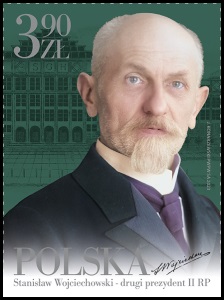
Stanisław Wojciechowski jest bardzo ważną osobą w społeczności akademickiej ówczesnej Wyższej Szkoły Handlowej, dla której pracował jako profesor w latach 1919–1939. Po objęciu urzędu prezydenta, jeszcze przez trzy miesiące wykładał historię i teorię kooperacji na uczelni. Podczas politycznej emerytury powrócił do pracy naukowej oraz akademickiej, prowadząc wykłady z historii ruchu spółdzielczego.
– Jesteśmy dumni, że Stanisław Wojciechowski to Prezydent z SGH. Szkoła Główna Handlowa w Warszawie chyba nie mogła sobie wymarzyć lepszego bohatera – i bohatera tamtego okresu, i bohatera dla nas. Profesor Wojciechowski postępował zgodnie z tymi wartościami, które zostały przez nas przyjęte za własne, a są nimi prawda, uczciwość, szacunek do drugiego człowieka, współpraca i profesjonalizm – podkreślił dr hab. Piotr Wachowiak, profesor i rektor Szkoły Głównej Handlowej w Warszawie.

Życie Stanisława Wojciechowskiego … Stanisław Wojciechowski urodził się 15 marca 1869 r. w Kaliszu. W 1888 r. zaczął studia na Uniwersytecie Warszawskim, podczas których działał w studenckiej konspiracji. W 1892 r. był zmuszony opuścić Warszawę. Wyjechał do Zurychu, a następnie Paryża i Londynu. Na emigracji współtworzył Polską Partię Socjalistyczną, drukował „bibułę”, dostarczał do kraju broń i maszyny drukarskie. W 1906 r. powrócił do Warszawy, gdzie zajął się organizacją polskiej spółdzielczości. W 1919 r. został ministrem spraw wewnętrznych. W tym samym czasie zaczął prowadzić wykłady w Wyższej Szkole Handlowej. Po zamordowaniu prezydenta Gabriela Narutowicza 20 grudnia 1922 r. został wybrany przez Zgromadzenie Narodowe na drugiego Prezydenta RP. W 1924 r. we Lwowie dokonano nieudanego zamachu na drugiego prezydenta II RP. W rezultacie tzw. zamachu majowego 14 maja 1926 r. Stanisław Wojciechowski zrezygnował ze stanowiska. Na politycznej emeryturze Wojciechowski powrócił do współpracy z uczelnią. Mieszkał w domu przy ul. Langiewicza 15, który został podpalony przez Niemców w czasie powstania warszawskiego. Razem z żoną przeszedł przez obóz w Pruszkowie, a następnie osiadł w Gołąbkach, gdzie zmarł niemal całkowicie zapomniany 9 kwietnia 1953 r. Pochowano go na Powązkach.

Pamiętamy 10.04.2010
We Rememmber 10.04.2010
www.poczta-polska.pl
W dniu 13 kwietnia 2023 r. został wprowadzony do obiegu znaczek pocztowy o wartości 3,90 zł emisji “Pamiętamy 10.04.2010″. Emisja poświęcona jest Władysławowi Stasiakowi (ur. 15 marca 1966 we Wrocławiu, zm. 10 kwietnia 2010 w katastrofie polskiego samolotu w Smoleńsku) – polski urzędnik państwowy i samorządowy; w 2007 Minister Spraw Wewnętrznych i Administracji, w latach 2007-2009 szef Biura Bezpieczeństwa Narodowego, w latach 2009-2010 szef Kancelarii Prezydenta RP. Na znaczku przedstawiono wizerunek Władysława Stasiaka na tle barw narodowych. Na kopercie przedstawiono motto ,,Dla Polski warto pracować” na tle barw narodowych. Na datowniku jest faksymile Władysława Stasiaka. Znaczki wydrukowano techniką offsetową , na papierze fluorescencyjnym, w formacie znaczka 43 x 31,25 mm, w nakładzie 120.000 sztuk. Arkusz zawiera 6 znaczków. Z tej okazji została wydana koperta FDC. Autor projektu:: Roch Stefaniak.
W hołdzie ofiarom Katastrofy Smoleńskiej Poczta Polska wyemitowała okolicznościowy znaczek pocztowy emisji „Pamiętamy 10.04.2010”. Walor prezentuje śp. Władysława Stasiaka, Szefa Kancelarii Prezydenta RP. Urzędnik, upamiętniony na znaczku, był jedną z 96 ofiar katastrofy rządowego samolotu Tu-154.
Głównym elementem projektu znaczka jest portret fotograficzny Władysława Stasiaka, który został przedstawiony na tle barw narodowych. Wybór kolorystyki podkreśla zaangażowanie upamiętnionego urzędnika dla umacniania polskiej państwowości. Emisji waloru towarzyszy koperta Pierwszego Dnia Obiegu (FDC), na której umieszczono patriotyczne motto tragicznie zmarłego Szefa Kancelarii Prezydenta RP: „Dla Polski warto pracować”. Całość projektu uzupełnia specjalny datownik, przedstawiający faksymile podpisu Władysława Stasiaka. Zestaw zaprezentowanych walorów filatelistycznych to forma hołdu wobec zasług Szefa Kancelarii Prezydenta RP oraz przypomnienia o jednej z największych tragedii w historii III RP.
– Katastrofa pod Smoleńskiem to jedno z najtragiczniejszych wydarzeń w najnowszej historii naszego kraju. Każdy z nas pamięta ten dzień. Nagła śmierć tak wielu wybitnych osobowości, wielkich i zasłużonych patriotów, pozostawiła po sobie olbrzymią pustkę. Jednym ze sposobów upamiętnienia ofiar Katastrofy Smoleńskiej są emisje znaczków oraz kopert wydawanych przez Pocztę Polską. Dzięki naszej działalności filatelistycznej możemy oddać hołd tym, którzy poświęcili swoje życie dla dobra Ojczyzny i promować ich dziedzictwo – podkreśla Krzysztof Falkowski, prezes Poczty Polskiej.

Odznaki i wyróżnienia Władysława Stasiaka świadczą o jego wielkich zasługach … Władysław Stasiak, za swoje zasługi, uhonorowany został wieloma międzynarodowymi odznaczeniami, m.in. Orderem Narodowym Zasługi (Francja, 2007), Krzyżem Wielkim Orderu Zasługi (Portugalia, 2009) i Krzyżem Komandorskim Orderu Zasługi (Węgry, 2009). W Ojczyźnie pośmiertnie przyznano mu Krzyż Komandorski z Gwiazdą Orderu Odrodzenia Polski. Otrzymał również tytuł honorowego obywatela Wrocławia, tytuł honorowego obywatela Dolnego Śląska (pośmiertnie, 2010), wyróżnienie Zasłużony dla Warszawy (pośmiertnie, 2010), Honorową Odznakę GROM (2007). Władysław Stasiak był również laureatem Nagrody im. Prezydenta Rzeczpospolitej Polskiej Lecha Kaczyńskiego.
Tegoroczny znaczek to trzeci walor honorujący ofiary katastrofy smoleńskiej … Ostatni znaczek pocztowy emisji „Pamiętamy 10.04.2010”, przedstawiający postać śp. Prezydenta Lecha Kaczyńskiego, ukazał się w 2020 r. Znaczkowi towarzyszyła koperta Pierwszego Dnia Obiegu (FDC), zawierająca cytat jego wypowiedzi, którą wygłosił w sierpniu 2008 r. w Tbilisi. Walory wydano wspólnie z Pocztą Gruzji, aby przypomnieć zasługi Prezydenta Lecha Kaczyńskiego dla niepodległości i suwerenności tego kraju. W 2017 r. do obiegu wprowadzone zostało wydawnictwo również tej emisji, prezentujące portret pary prezydenckiej, która zginęła w Katastrofie Smoleńskiej. Przestrzeń jego oprawy została uzupełniona nazwiskami wszystkich pozostałych ofiar tragicznego wypadku. Uroczystość została objęta Honorowym Patronatem Prezydenta RP @AndrzejDuda.

80r. rocznica wybuchu powstania w getcie warszawskim
www.poczta-polska.pl
W dniu 19 kwietnia 2023 roku został wprowadzony do obiegu znaczek pocztowy o wartości 3,90 zł emisji “80. rocznica wybuchu powstania w Getcie Warszawskim”. Na znaczku przedstawiono oficjalny logotyp obchodów 80. rocznicy wybuchu powstania w getcie warszawskim. Na kopercie FDC archiwalna fotografia budynku przy ulicy Siennej 60 w Warszawie wybudowanego w latach 1876-1878 jako Szpital dla Dzieci im. Bersohnów i Baumanów.
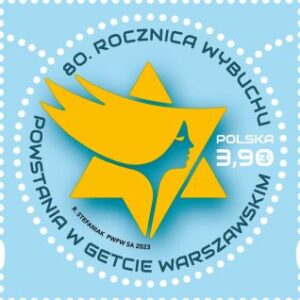
Budynek przetrwał wojnę, w 2014 r. obiekt przestał służyć celom leczniczym. 7 marca 2018 r. premier Mateusz Morawiecki oraz wicepremier i minister kultury Piotr Gliński ogłosili wspólnie, że budynek stanie się siedzibą Muzeum Getta Warszawskiego Znaczki wydrukowano techniką offsetową, na papierze fluorescencyjnym, w formacie 45 x 45 mm, w tym koło o średnicy 40 mm, w nakładzie 128 000 sztuk. Arkusz sprzedażny zawiera 8 sztuk znaczków. Z tej okazji została wydana koperta FDC. Autor projektu: Roch Stefaniak.

900-lecie Diecezji Włocławskiej
www.poczta-polska.pl
W dniu 22 kwietnia 2023 został wprowadzony do obiegu znaczek pocztowy o wartości odpowiadającej opłacie za list ekonomiczny krajowy w formacie S emisji “900-lecie Diecezji Włocławskiej”. Na znaczku przedstawiono krzywaśń pastorału bpa Macieja z Gołańczy oraz herb diecezji włocławskiej, na kopercie – bullę papieża Eugeniusza III z 1148 r. oraz katedrę pw. Wniebowzięcia NMP we Włocławku. Natomiast na datowniku – znak wizualizujący nawiedzenie Matki Bożej w znaku kopii Ikony Jasnogórskiej oraz Jubileusz 900-lecie istnienia Diecezji Włocławskiej. Znaczek wydrukowano techniką rotograwiurową, na papierze fluorescencyjnym w formacie 31,25 x 25,5 mm, w nakładzie wielomilionowym, powtarzalnym. Arkusz sprzedażny zawiera 100 znaczków. Z tej okazji została wydana również koperta FDC. Autor projektu: Poczta Polska.
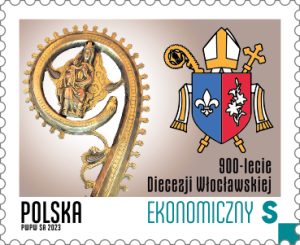
Walor obiegowy emisji „900-lecie Diecezji Włocławskiej” to kolejne wydawnictwo filatelistyczne Poczty Polskiej, które upamiętnia ważne rocznice i jubileusze dotyczące postaci i obiektów sakralnych przyczyniających się do budowania tożsamości religijnej Polaków. Projekt znaczka przedstawia krzywaśń pastorału bpa Macieja z Gołańczy oraz herb diecezji włocławskiej. W grafice koperty Pierwszego Dnia Obiegu (FDC) zaprezentowano bullę papieża Eugeniusza III z 1148 r. oraz widok katedry pw. Wniebowzięcia NMP we Włocławku. Na datowniku znalazło się logo jubileuszu z kopią ikony Jasnogórskiej oraz nazwą emisji.
– Poczta Polska wśród bogatej tematyki wydawnictw filatelistycznych przybliża również dzieje Kościoła katolickiego. Nową emisją pragnie uczcić jubileusz Diecezji Włocławskiej, która obok gnieźnieńskiej czy krakowskiej na przestrzeni wieków stanowiła jedną z najbardziej istotnych i znaczących diecezji. Unikalną odsłoną znaczka pocztowego pragniemy wyrazić nasze podziękowanie za 900 lat posłannictwa duszpasterskiego – podkreślił Wiesław Włodek, wiceprezes Poczty Polskiej.

Diecezja Włocławska jest jedną z trzech diecezji obrządku łacińskiego w metropolii gnieźnieńskiej w Polsce, z którą związana była od początku jako jej diecezja sufraganalna. Podczas zaborów została włączona do metropolii warszawskiej. Od 1925 r., po odzyskaniu przez Polskę niepodległości, ponownie podporządkowano ją metropolicie gnieźnieńskiemu. Współcześnie pozostała w swojej macierzystej prowincji kościelnej. W tej diecezji urodzili się oraz spędzili pierwsze lata życia: św. siostra Faustyna Kowalska i św. ojciec Maksymilian Maria Kolbe. Na jej terenie poniósł śmierć męczeńską bł. ks. Jerzy Popiełuszko.

Owady pożyteczne
www.poczta-polska.pl
W dniu 24 kwietnia 2023 r. zostały wprowadzone do obiegu dwa znaczki pocztowe o wartości 3,90 zł każdy, emisji “Owady pożyteczne”. Na znaczku przedstawiono rysunki owadów pożytecznych:
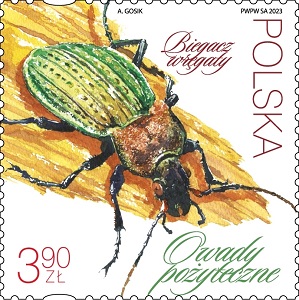
na pierwszym – Biegacza wręgatego: zarówno larwy, jak i osobniki dorosłe prowadzą drapieżny tryb życia: zjadają ślimaki, mszyce czy larwy stonki ziemniaczanej. Biegacze potrafią rozwijać duże prędkości przy stosunkowo niewielkich rozmiarach – do pokonania 1 metra potrzeba im zaledwie 10 sekund. Inną ciekawostką jest fakt, że zaniepokojone potrafią wystrzelić na odległość 25 cm (10 razy więcej niż same mierzą) ,,kulę” z substancjami chemicznymi, odstraszającymi wrogów. Są to owady na tyle ciekawe, że doczekały się własnego działu w wśród nauk entomologicznych – karabidologii.

na drugim – Omomiłka wiejskiego: ogranicza chrząszcze i larwy drapieżnych owadów, w tym wielu szkodników; żyjące na ziemi larwy żywią się ślimakami, dżdżownicami i różnymi owadami, a osobniki dorosłe – drobnymi owadami, pyłkiem kwiatowym.

Tegoroczna emisja stanowi kontynuację serii Owady pożyteczne, rozpoczętej w 2021 r. (6 znaczków – owady zapylające) – i jest wynikiem ścisłej współpracy z Ministerstwem Rolnictwa i Rozwoju Wsi. Znaczki wydrukowano techniką offsetową z wykorzystaniem rastra stochastycznego, na papierze fluorescencyjnym, w formacie 40,5 x 40,5 mm, w nakładzie: 135 000 szt. każdego znaczka. Z tej okazji została wydana koperta FDC.


Stanisław Wojciechowski
www.nbp.pl
Narodowy Bank Polski jest centralnym bankiem państwa odpowiadającym za politykę pieniężną i stabilność cen. Jego funkcje określa Konstytucja Rzeczypospolitej Polskiej i ustawa o NBP. NBP ma wyłączne prawo emisji pieniądza. Jako bank centralny nie prowadzi rachunków bankowych obywateli, nie przyjmuje od nich lokat, nie udziela kredytów. Prowadzi natomiast obsługę budżetu państwa, a także podmiotów sektora finansów publicznych. Gromadzi rezerwy walutowe państwa i zarządza nimi. Pełni funkcję banku banków, tworząc warunki do działania systemu bankowego. Jest również jednym z najważniejszych ośrodków naukowo-analitycznych w dziedzinie ekonomii i rynków finansowych.
Emisja wartości kolekcjonerskich stanowi okazję do upamiętniania ważnych historycznych rocznic i postaci oraz do rozwijania zainteresowań polską kulturą, nauką i tradycją. 4 kwietnia 2023 roku Narodowy Bank Polski wprowadził do obiegu srebrną monetę o nominale 10 zł „Stanisław Wojciechowski”.
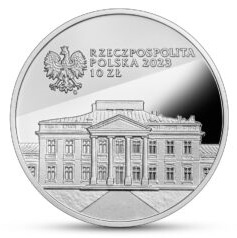
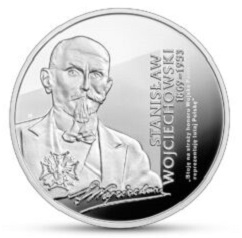
Nominał 10 zł … metal: Ag 925/1000; stempel: lustrzany; średnica: 32,00 mm; masa: 14,14 g; brzeg (bok): gładki; nakład: do 10 000 szt.; Projektant: Dominika Karpińska-Kopiec; Emitent: NBP; Na zlecenie NBP monety wyprodukowała Mennica Polska S.A.
Na rewersie monety znajdują się: wizerunek Stanisława Wojciechowskiego wraz z faksymile jego podpisu, daty urodzin i śmierci, Order Orła Białego, którym został odznaczony, oraz cytat z wypowiedzi jako prezydenta z 12 maja 1926 r. Awers monety przedstawia historyczny wizerunek budynku Belwederu.
Stanisław Wojciechowski urodził się w 1869 r. w Kaliszu w zubożałej rodzinie szlacheckiej. W 1888 r. rozpoczął studia na Cesarskim Uniwersytecie Warszawskim, gdzie wstąpił do tajnego Związku Młodzieży Polskiej „Zet” założonego przez emigracyjną Ligę Polską. Od 1890 r. należał do Centralizacji (władz naczelnych) Zetu. Niemal równocześnie został także członkiem Zjednoczenia Robotniczego. Pozostawał wówczas pod dużym wpływem Edwarda Abramowskiego i jego filozofii. W 1892 r. zmuszony do emigracji współtworzył Związek Zagraniczny Socjalistów Polskich i Polską Partię Socjalistyczną, a jako emisariusz na kraj formował konspiracyjną PPS i współredagował 25 numerów „Robotnika”. W czasie rewolucji 1905 r. zrezygnował z członkostwa w partii kierowanej przez „młodych”, którzy wykreślili z programu postulat walki o niepodległość, i wycofał się z działalności konspiracyjnej. Jeszcze w 1899 r. ożenił się z Marią Kiersnowską, z którą miał dwójkę dzieci – Edmunda i Zofię (wyszła za mąż za Władysława Jana Grabskiego, syna Władysława). W 1906 r. osiadł w Warszawie, gdzie współtworzył ruch spółdzielczy. Doprowadził do założenia Warszawskiego Związku Stowarzyszeń Spożywczych, którego był dyrektorem w latach 1911–1915.
Był także redaktorem czasopisma „Społem”. W 1914 r., po wybuchu wojny, został członkiem Centralnego Komitetu Obywatelskiego miasta Warszawy i Komitetu Narodowego Polskiego, a po wyjeździe na wschód w 1915 r. – Centralnego Komitetu Obywatelskiego Królestwa Polskiego w Rosji. Tam współpracował ściśle z późniejszym premierem i przyjacielem Władysławem Grabskim z tajnej Ligi Narodowej, niosąc pomoc uchodźcom. Po wybuchu rewolucji lutowej w Rosji stanął na czele Rady Polskiej Zjednoczenia Międzypartyjnego, zdominowanej przez narodowych demokratów. Po powrocie do Polski, od stycznia 1919 r. zasiadał w gabinecie Ignacego J. Paderewskiego (następnie Leopolda Skulskiego) jako minister spraw wewnętrznych. Zaangażował się w przygotowanie projektu konstytucji, zorganizował resort, administrację państwową i samorządową oraz policję państwową. W 1921 r. wstąpił do PSL „Piast” i z ramienia tej partii został wybrany w wyborach prezydenckich po śmierci Gabriela Narutowicza. Jako prezydent w latach 1922–1926 musiał gasić liczne konflikty polityczne i partyjne.
Okazał się stanowczy, gdy 12 maja 1926 r. na moście Poniatowskiego w Warszawie stanął twarzą w twarz z Piłsudskim i towarzyszącymi mu oficerami. „Stoję na straży honoru Wojska Polskiego, reprezentuję tutaj Polskę” – miał mu powiedzieć, zastępując drogę do budynków urzędów konstytucyjnych. Wobec przedłużających się walk w stolicy podał się do dymisji. W okresie rządów sanacji ponownie działał w ruchu spółdzielczym i prowadził wykłady w Szkole Głównej Gospodarstwa Wiejskiego oraz w Szkole Głównej Handlowej. Wydawał też kolejne prace na temat spółdzielczości; pisał wspomnienia. W czasie II wojny światowej pozostał w Warszawie. W 1941 r. w KL Auschwitz zginął jego syn, zesłany tam wraz z innymi polskimi adwokatami, którzy odmówili okupantowi skreślenia z listy palestry kolegów pochodzenia żydowskiego. Po aresztowaniu syna Niemcy proponowali Wojciechowskiemu podpisanie oświadczenia lojalności wobec III Rzeszy. Odmówił. Podczas Powstania Warszawskiego omal nie stracił życia wraz z żoną w podpalonym przez Niemców domu rodzinnym. Po upadku Warszawy trafił do obozu w Pruszkowie, a po wojnie zamieszkał wraz z rodziną Grabskich w Gołąbkach nieopodal stolicy. Tam zmarł 9 kwietnia 1953 r. Został pochowany na cmentarzu Powązkowskim. Informacja: Jan Żaryn.

Stanisław Wojciechowski
www.nbp.pl
Narodowy Bank Polski is the central bank of the State, responsible for its monetary policy and price stability. The Bank’s functions are described in the Constitution of the Republic of Poland and the Act on NBP. NBP holds the exclusive right to issue the currency of the Republic of Poland. As the central bank, it does not provide accounts for the general public, accept deposits from or extend loans to individuals. It acts as a banker to the State budget and public sector entities. NBP also holds and manages the foreign exchange reserves of the State. Finally, it functions as a banker to banks, creating conditions for the operation of the Polish banking system. Narodowy Bank Polski is one of the most important research and analytical centres in the fields of economics and financial markets.
Issuing collector items is an occasion to commemorate important historic figures and anniversaries, as well as to develop the interest of the public in Polish culture, science and tradition. On 4 April 2023, Narodowy Bank Polski issued into circulation a silver coin “Stanisław Wojciechowski”, with a face value of 10 złoty.


Face value: 10 zł … Metal: Ag 925/1000; Finish: proof; Diameter: 32.00 mm; Weight: 14.14 g; Edge (side): plain; Mintage: up to 10,000 pcs; Designer: Dominika Karpińska-Kopiec; Issuer: NBP; The coins, commissioned by NBP, were struck by Mennica Polska S.A.
The reverse of the coin shows an image of Stanisław Wojciechowski and a facsimile of his signature, as well as the dates of his birth and death, the Order of the White Eagle, with which he was decorated, and a quotation of his words as president on 12 May 1926. The obverse of the coin shows the historic Belvedere Palace.
Stanisław Wojciechowski was born in 1869 in Kalisz into an impoverished gentry family. In 1888, he started studying at the Imperial Warsaw University, where he joined the clandestine Association of the Polish Youth “Zet” established by the émigré Polish League. From 1890, he was a member of “Centralizacja” (the governing body) of “Zet”. Almost at the same time, he joined the Workers Union. At the time, he was strongly influenced by Edward Abramowski and his philosophy. Forced to emigrate in 1892, he went on to co-found the Association of Polish Socialists Abroad and the Polish Socialist Party (“PPS”), and in the capacity of an emissary to partitioned Poland, he formed the underground PPS and co-edited 25 issues of the newspaper “Robotnik” (“The Worker”). During the Russian revolution of 1905, Wojciechowski relinquished his membership in the party, then led by the “youth”, who had deleted the fight for an independent Poland from its manifesto, and withdrew from the underground activity. In 1899, Stanisław Wojciechowski married Maria Kiersnowska, with whom he had two children, Edmund and Zofia (who later married Władysław Jan Grabski, the son of Władysław Grabski).
In 1906, he settled in Warsaw, where he co-created the cooperative movement. He was instrumental in the establishment of the Warsaw Union of Consumer Associations, of which he was the director in 1911–1915. He was also an editor in the periodical “Społem” (“Together”). After the war broke out in 1914, Wojciechowski became a member of the Central Civic Committee of the City of Warsaw and the Polish National Committee, and then, following his travel to the East in 1915 – he sat on the Central Civic Committee of the Kingdom of Poland in Russia. There, he closely collaborated with Władysław Grabski of the secret National League, the future Prime Minister of Poland and a friend of Wojciechowski’s, providing aid to refugees. When the February Revolution broke out in Russia, Wojciechowski took the lead of the Council of the Polish Parties’ Union, dominated by national democrats. Following his return to Poland, in January 1919 Wojciechowski became minister of the interior in the cabinet formed by Ignacy Jan Paderewski and then in the cabinet of Leopold Skulski. He was involved in the drafting of the constitution and organised the ministry, the state administration and the local government administration, as well as the national police force. In 1921, Wojciechowski joined PSL “Piast” and as a representative of that party, he was elected president of Poland after the death of Gabriel Narutowicz. Holding the office of president in the years 1922–1926, he had to resolve numerous political conflicts and rivalries between the parties.
He proved himself as a firm statesman when on 12 May 1926 he faced Józef Piłsudski and the officers accompanying him on the Poniatowski Bridge in Warsaw. “I guard the honour of the Polish military and represent Poland here,” he is believed to have said to Piłsudski, barring his way to the buildings housing the constitutional state offices. As the fighting in the capital city protracted, he handed in his resignation. During Sanation rule, Wojciechowski again became active in the cooperative movement and gave lectures at the Warsaw University of Life Sciences and the Warsaw School of Economics. He also published a series of papers on the cooperative movement and wrote his memoirs. During World War II, Wojciechowski remained in Warsaw. In 1941, his son was killed in KL Auschwitz. He had been sent there with other Polish lawyers who had refused to disbar their Jewish colleagues on demand of the occupiers. After arresting his son, the Germans asked Wojciechowski to sign a declaration of loyalty to the Third Reich, which he refused to do. He and his wife nearly died during the Warsaw Uprising when the Germans set fire to their family house. When Warsaw fell, he was relocated to a camp in Pruszków and after the war he moved in with the Grabski family to Gołąbki near Warsaw, where he died on 9 April 1953. He was buried in the Powązki Cemetery. Info: Jan Żaryn.


2023 Canada Post Community Foundation:
Permanent™ domestic rate stamps –
booklet of 10 + $1 donation
www.canadapost.ca
Take home this booklet of 10 Permanent™ domestic rate stamps from our 2023 Canada Post Community Foundation stamp issue to support organization that support Canadian children and youth.
About the issue … Sharing stories enriches our lives in so many ways. Through the Canada Post Community Foundation, we contribute resources that inspire creativity and curiosity, and our annual semi-postal fundraising issue gives you a way to contribute.

About the design … The theme of this stamp issue is the way in which stories and storytelling enhance the lives of children and youth. The illustration by John Belisle depicts a diverse group of animals reading a story together. It reminds us of the joy that stories and storytelling bring, as well as the creativity and curiosity they inspire.
About the donation … When you purchase a booklet of 10 stamps, a donation of $1 will go directly to fund local and national non-profit groups that assist Canadian children and youth in writing the next chapter of their lives. Since 2012, the Canada Post Community Foundation has supported more than 1,100 community organizations that bring positive change to Canadian children.
Stamp Designer: John Belisle Creative; Stamp Illustrator: John Belisle; Stamp Value Permanent™ domestic rate plus the 10-cent surcharge on each stamp; Quantity Produced: 250,000; Issue Date May 1, 2023.

Take home this Official First Day Cover (OFDC) from our 2023 Canada Post Community Foundation stamp issue that helps to fund organizations that support Canadian children and youth.
OFDC design … The theme of this stamp issue is the way in which stories and storytelling enhance the lives of children and youth. The OFDC illustration by John Belisle depicts a diverse group of animals gathering around a fire in the forest to read a story together. It reminds us of the joy that stories and storytelling bring, as well as the creativity and curiosity they inspire. The stamp is cancelled in Ottawa, Ontario.
Donation … When you purchase the OFDC, a donation of 10 cents from the stamp affixed will go to fund local and national non-profit groups that assist Canadian children and youth in writing the next chapter of their lives. Since 2012, the Canada Post Community Foundation has supported more than 1,100 community organizations that bring positive change to Canadian children.
Cancellation Site: Ottawa ON; Stamp Designer: John Belisle Creative; Stamp Illustrator: John Belisle; Stamp Value: Permanent™ domestic rate plus the 10-cent surcharge on each stamp; Quantity Produced: 8,000; Issue Date: May 1, 2023.


2023 … $20 Pure Silver Coin –
Colourful Birds: Northern Cardinal
www.mint.ca
Enjoy a bird-theme showcase of Mother Nature’s contrasting colours. Easily recognized by its pointed crest, the cardinal’s bright red plumage adds a welcome splash of colour to our landscapes in any season. But its conspicuous appearance can also lift our spirits on a quiet winter day, when most of nature’s colours are tucked under a thick blanket of snow—as seen on this selectively coloured 99.99% pure silver coin.
Selective Colour …A selective application of colour highlights one of winter’s brightest colour displays, courtesy of a bright red cardinal and some winter-hardy plant species, transforming this design into a celebration of Mother Nature’s contrasting colours—just as it did with 2021’s Blue Jay and 2022’s Cedar Waxwing. An immersive view … The raised perspective pulls you into the scene and creates the impression of standing directly behind the cardinal, among the evergreens.
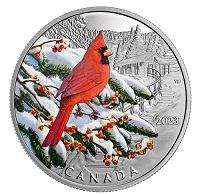
Face value: 20 dollars … Composition: 99.99% pure silver,
with selective colour; Mintage: 7,500; Finish: Proof;
Weight: 31.39 g; Diameter: 38 mm; Edge: serrated; Artist:
Tony Bianco (reverse), Susanna Blunt (obverse);
Packaging: Black clamshell with black beauty box.
DID YOU KNOW? … ***Brighter is better: Those crimson-coloured feathers are key to mating success for the male, whereas the female is a more subdued mix of tan and grey colours. ***Male cardinals are rather territorial: they can mistake their reflection for a possible intruder and may spend hours fighting this imagined threat! ***Canada’s northern cardinal population is steadily increasing thanks to backyard feeders (cardinals love sunflower seeds). The year-round resident was largely limited to south eastern regions of Canada but recently, it has been spotted as far west as Manitoba and east in Newfoundland and Labrador.
Designed by Canadian artist Tony Bianco, your coin’s selectively coloured reverse features a tranquil winter scene after snowfall. A snow-blanketed house on a hill appears in the engraved background. In the foreground, a bright red northern cardinal (Cardinalis cardinalis) is perched on a bittersweet (Celastrus candens) branch in a spruce tree. The obverse features the effigy of Queen Elizabeth II by Susanna Blunt. The obverse also bears a special marking that includes four pearls symbolizing the four effigies that have graced Canadian coins and the double date of her reign.
Tony Bianco, Artist … The background in this design comes from my walks on my property. Sun and snow on the pines makes for a very clean and bright setting in which to find the surprisingly vivid red and black colours of the male cardinal. I’m always happier after having seen one!

2023 … $20 Fine Silver Coin –
Super Incuse Silver Maple Leaf
www.mint.ca
Black rhodium and super incuse—a striking combination that leaves a deep impression. For the 2023 edition, we’ve combined two stand-out features—black rhodium plating from 2020, and the 1.5 mm super incuse depth that set a new standard in 2021—to give our Silver Maple Leaf (SML) design a more modern edge. This special edition of the SML is a study in contrasts: it mixes standard raised relief with a super-incused strike, and a reverse proof finish (frosted field, brilliant relief) with the sleek satin look of black rhodium plating. The result is a fresh take on a familiar design—it’s contemporary, it’s captivating, and it is sure to leave a lasting impression.
Bold black rhodium … To emphasize the incuse strike and add a modern edge, the deeply recessed maple leaf has been plated with black rhodium. Black rhodium plating also fills the field on the coin’s obverse, and it darkens both the coin’s edge and rim to boldly frame the reverse. Reverse proof finish … This coin is a study in contrasts, especially with its lightly frosted field and brilliant relief. The reverse proof finish pairs beautifully with the satin sheen of black rhodium to achieve an ultra-modern look that exudes sophistication and truly makes the maple leaf pop!
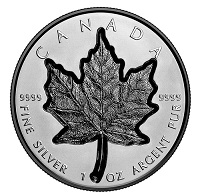
Face value: 20 dollars … Composition: 99.99% pure silver, with selective black rhodium plating; Mintage: 8,000; Finish: Proof; Weight: 32.4 g; Diameter: 36.08 mm; Edge: serrated; Artist: Walter Ott (reverse), Susanna Blunt (obverse); Packaging: Black clamshell with black beauty box.
DID YOU KNOW? … ***The SML’s iconic maple leaf is the same one that appears on the Gold Maple Leaf (GML) coin – in fact, that’s where it made its debut. Former Chief Engraver Walter Ott (1920-2020) created the design for the first GML bullion coin issued in 1979, and it has since become the signature design for all our Maple Leaf bullion coins and special issues. ***The leaf on this coin is that of the sugar maple, Acer saccharum. True to its name, the sugar maple’s sap has the highest concentration of sugar, and that’s why this Canadian maple is prized by maple syrup producers.
Your coin’s reverse features Walter Ott’s iconic sugar maple leaf design, unchanged since the first Silver Maple Leaf (SML) bullion coin issued in 1988. Struck incuse, the distinctive sugar maple leaf is plated with black rhodium and reaches a depth of 1.5 millimetres. The coin’s reverse proof finish emphasizes the brilliant relief, including the engraved words “CANADA”, “FINE SILVER 1 OZ ARGENT PUR” and the purity standard of “9999” on the reverse. Black rhodium plating also fills the field on the obverse, which features the effigy of Queen Elizabeth II by Susanna Blunt. The obverse also bears a special marking that includes four pearls symbolizing the four effigies that have graced Canadian coins and the double date of her reign.

2023 … $30 Fine Silver Coin – Vantage Point –
Bald Eagle by Robert Bateman
www.mint.ca
Your exclusive opportunity to own an engraved rendering of a Robert Bateman original. A symbol of strength and resilience in the wild, the bald eagle is a regal sight to behold on this 2 oz. 99.99% fine silver coin. The coin’s reverse presents an engraved take on Vantage Point – Bald Eagle, an original work of art by world-renowned wildlife artist Robert Bateman. Its depiction of the bald eagle elicits feelings of awe, even in this quiet moment, as the majestic bird sits on its moss-covered perch and defiantly faces into the wind.
An eagle portrait … Your coin’s reverse features a masterfully engraved adaptation of Robert Bateman’s Vantage Point – Bald Eagle. It is the latest in a growing list of famous Bateman originals that have been re-created on Canadian coins, including 2019’s Into the Light – Lion, 2020’s Summertime Polar Bear, 2021’s Wolf Sketch and 2022’s Snowy Owl on Driftwood. Collect them all! The artist’s signature … Like a limited-edition print, your coin’s reverse includes the artist’s (engraved) signature. A fine silver work of art … Your coin has been beautifully crafted from 2 oz. of 99.99% pure silver. Its 50 mm diameter provides a larger sized canvas for the finely engraved details that capture the spirit of both the original painting and its subject.
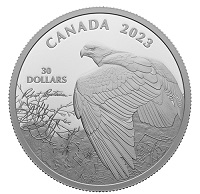
Face value: 30 dollars … Composition: 99.99% pure silver;
Mintage: 5,500; Finish: Proof; Weight: 62.69 g;
Diameter: 50 mm; Edge: serrated; Artist:
Robert Bateman (reverse), Susanna Blunt (obverse);
Packaging: Black clamshell with black beauty box.
DID YOU KNOW? … ***One of Canada’s most recognized and honoured artists, Robert Bateman is an unflagging proponent of wildlife conservation and education. His photo-realistic art reflects his deep love of nature and his commitment to its preservation. ***The artist has long been an advocate of wildlife education and learning initiatives that deepen one’s connection with nature, such as those carried out by the Bateman Foundation batemanfoundation.org . Based in Victoria, B.C., the Foundation oversees the Bateman Gallery, home to the largest permanent collection of original works by Robert Bateman. The Batemans have also donated millions of dollars’ worth of artwork and limited-edition prints throughout the years to help fund conservation efforts across Canada.
Your coin’s reverse is an engraved adaptation of Vantage Point – Bald Eagle, an original work of art by Canadian wildlife artist Robert Bateman. It features a side view of a bald eagle (Haliaeetus leucocephalus) perched on the moss-covered roots of an uprooted tree. The coin’s luminous silver surface stands in for the original painting’s misty grey sky, where the text “CANADA 2023” appears, while the artist’s signature is engraved beneath a denomination of “30 DOLLARS”. The obverse features a nature-themed pattern and the effigy of Queen Elizabeth II by Susanna Blunt. The obverse also bears a special marking that includes four pearls symbolizing the four effigies that have graced Canadian coins and the double date of her reign.
Robert Bateman … “Like a massive shadow, the eagle sweeps along the coast. Finding a vantage point, he lands. Facing into the wind from the sea, he adjusts his wings. Once the king of the sky across the continent, the bald eagle has been forced to retreat because of the pesticides and development pressures, but in coastal areas as far apart as Florida and Alaska, he is not only surviving, but thriving. He is noted as a bold or clever hunter or fisherman, and so the edge of the sea provides easy fare for his diet. In this painting I wanted to emphasize the thrust into the wind of the bird, the uprooted tree, and the rocky spit. These elements project into space toward an endless horizon. In contrast is the rich tangle of mosses and other plants which have colonized the stump. I was almost suggesting a Japanese bonsai garden with a little hemlock tree dwarfed by the elements.”

Pure Gold Coin – The Curious Marten
www.mint.ca
Shiny and tiny—this little gold coin and its baby marten will capture your heart. Captured on our smallest (14 mm) blank and in 99.99% pure gold, the baby marten (or kit) is furry, energetic, and oh so adorable! This cute resident of Canada’s boreal forests will grow up to be a solitary hunter and an agile forager that deftly moves among the trees in search of berries, nuts, insects and small mammals. But before reaching maturity, a marten kit is reliant on its mother until the fourth month—that’s when it is finally ready to make its first foray out of the den and into the forest, as seen on this coin.
Affordably sized, precisely crafted … While your coin’s 14 mm diameter makes it slightly smaller than a 10-cent piece, you’ll find an incredible wealth of engraved details on its reverse. A captivating Canadian species … The bushy-tailed marten (also known as the pine marten) isn’t often featured on our coins but is found throughout Canada, where it resides in the boreal forests that stretch from east to west and into the north.
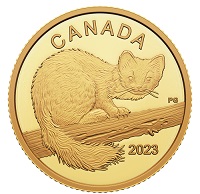
Face value: 10 dollars … Composition: 99.99% pure gold;
Mintage: 3,000; Finish: Proof; Weight: 1.58 g;
Diameter: 14.1 mm; Edge: serrated; Artist:
Pierre Girard (reverse), Susanna Blunt (obverse);
Packaging: Black clamshell with black beauty box.
DID YOU KNOW? … ***A member of the Mustelidae family that includes weasels, wolverines and skunks, an adult marten (or pine marten) is roughly the size of a housecat, but with a slender body and shorter legs. A sub-species, the Newfoundland marten, is only found in the province of Newfoundland and Labrador. ***The baby marten depicted on your coin is already a few months old. After finding a suitable tree hollow or abandoned den, the mother gives birth to two to four babies in March/April. Each newborn weighs just 30 grams but they grow quickly! The mother nurses her young until early summer, and the juveniles are on their own by the fall. ***The marten’s silky coat has traditionally commanded a high price in the fur industry, where it is sometimes marketed as Canadian sable.
Designed by Canadian wildlife artist Pierre Girard, your coin’s reverse features a charming portrait of a marten kit. The young animal is perched on the branch of a tree with its bushy tail hanging down, as it turns to face the viewer. The obverse features the effigy of Queen Elizabeth II by Susanna Blunt. The obverse also bears a special marking that includes four pearls symbolizing the four effigies that have graced Canadian coins and the double date of her reign.

Pure Silver Coin with Black Light Effect –
Pingualuit Crater: Crystal Eye of Nunavik
www.mint.ca
Discovery the beauty of Pingualuit Crater Lake… then activate the black light paint technology to see how it came to be! In the heart of the lunar-esque landscape of the Ungava Peninsula, in Nunavik, Quebec, lies a breathtaking lake with pure blue waters that stand out in any aerial view. A geological marvel, Pingualuit Crater Lake was created when a meteorite struck the Earth approximately 1.4 million years ago. This colourful 99.99% pure silver coin offers you an awe-inspiring view of the natural wonder: under normal light, you see the Crystal Eye of Nunavik peering out into space; under a black light, the reverse design whisks you back in time for a view of the landscape-altering meteorite, mere moments before it slammed into prehistoric Canada and left an almost perfectly circular impact scar.
Two scenes on one coin … Your coin’s reverse features a colourful space view of Pingualuit Crater Lake on the Ungava Peninsula, in Nunavik, Quebec. But a second image—one that only reveals itself under a black light—whisks you back in time, for a view of the meteorite on its collision course with prehistoric Canada and above the eventual impact site. Black light flashlight included … Each coin comes with a black light flashlight: simply point the light at the coin for a few seconds to activate the embedded paint technology, and watch as the blue lake suddenly appears! Wonders of the solar system … Already colourful, the space setting includes a Moon view and a glimpse of the Milky Way; these elements, as well as Earth’s edge and the lake below, glow when the black light technology is activated.
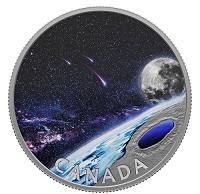
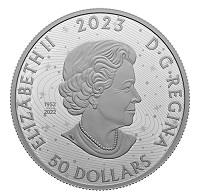
Face value: 50 dollars … Composition: 99.99% pure silver,
with black light paint technology; Mintage: 2,500; Finish: Proof;
Weight: 157.6 g; Diameter: 65.25 mm; Edge: serrated; Artist:
Neil Hamelin (reverse), Susanna Blunt (obverse);
Packaging: Black clamshell with black beauty box.

DID YOU KNOW? … ***Meteorites often strike at an angle, but the one that created Pingualuit Crater Lake came down almost vertically, resulting in the near-perfect circle imprinted on the earth’s surface. The impact created a ring that measures 3.4 kilometres in diameter, and when the ice sheet receded during the last ice age, water filled the crater to form a lake that is 267 metres deep. Because there are no inflows or outlets, the lake holds some of the clearest freshwater on Earth. It’s also home to a single species of fish, the Arctic char… though no one knows how the fish got there.
***Formerly known as Chubb Crater and New Quebec Crater, Pingualuit Crater Lake was the first meteorite crater to be recognized in Canada (others have since been identified). Local Nunavimmiut have long known about its existence, and it is regarded as a sacred site of healing. Outside of the Pingualuit region, the crater lake was a well-kept secret until 1943, when an American aircrew spotted it. Its unusual shape and vivid colour made it a useful navigational aid for pilots, and because of its remote location, geological expeditions to the crater didn’t begin until the 1950s.
***Thanks to the crater’s deep (400 metres) shape, sediment deposits at the bottom of Pingualuit Crater Lake escaped glacial erosion and are remarkably well preserved. These sediments have yielded information about climate change, and they provide a long-term record of environmental history dating back to (at least) the last two glacial periods.
Designed by Canadian artist Neil Hamelin, your coin’s reverse features a colourful space view of Pingualuit Crater Lake on the Ungava Peninsula, in Nunavik, Quebec. Above the blue circular lake and its (engraved) surroundings, the detailed depiction of the Moon, the shooting stars and the Milky Way inspire awe for the wonders of the cosmos, and a deeper understanding of both the splendour and vulnerability of Earth. These elements glow when viewed under black light, which reveals a second image: a view of the meteorite on its collision course with Earth and directly above its eventual impact site. The obverse features the effigy of Queen Elizabeth II by Susanna Blunt. The obverse also bears a special marking that includes four pearls symbolizing the four effigies that have graced Canadian coins and the double date of her reign.
Neil Hamelin, Artist … “It was an incredible amount of fun designing this coin and telling the story of pre and post impact of the Pingauluit Crater. I hope this coin will have a similar impact!”
Dr. Reinhard Pienitz, Professor, Department of Geography at Université Laval … One of the world’s deepest crater lakes, Pingualuit Crater Lake is stunning and truly unique because of its perfect circular shape, its deep blue colour, and its steep crater rim that stands out significantly over the flat tundra landscape. This site has caught the attention and imagination of scientists because the lake’s origins are extraterrestrial, and because its waters are among the purest in the world; fed only by rain, the lake basically emulates a huge rainwater collector in the middle of the barren tundra! But the real treasure is the wealth of stories its deep waters and sediments can tell. Deciphering the 1.4-million-year history of natural climate variability from the Pingualuit Crater Lake sediment archives will reveal important clues about climate change and how ecosystems adapted over many glacial-interglacial age cycles—in essence, Pingualuit Crater Lake is a precious scientific time capsule. Mary A. Pilurtuut, Pingualuit Park. Director … The weather was perfect, enough wind to keep the mosquitoes away when I first saw the crater and marvelled at the beauty of its deep blue colours. I put my feet in to really feel it’s beauty.

Pure Silver Diamond-Shaped Coin –
Forevermark Black Label Oval Diamond
www.mint.ca
For that elegant, elongated look: A Forever mark Black Label OVAL diamond inspired (and enhances) this 99.99% pure silver coin. THIRD silver diamond-shaped coin! Typically bursting with brilliance, an oval-cut diamond’s elongated shape adds to its sparkling allure—it’s the sophisticated choice for those seeking the fire and brilliance of a round cut diamond, but in a more distinct shape. Its eye-catching oval silhouette, along with its complex faceting structure, inspired our third 99.99% pure silver diamond-shaped coin. Another dazzling showpiece, this limited-edition collectible is shaped to match the patented cut of the 0.23 carat Forever mark Black Label oval diamond embedded on one of its facets, where the precision-cut gemstone radiates beauty and elegance.
Features a 0.23-carat forever mark diamond … Embedded on one of the coin’s engraved facets, the 0.23-carat Forever mark Black Label Oval Diamond and its complex, patented cut inspired this premium collectible’s multi-dimensional shape and facets. A Canadian sparkler … Canada is one of the world’s largest diamond producers. This coin has the added distinction of featuring a piece of Canada’s mining history: its diamond having been sourced from one of Canada’s finest diamond mines. The coin itself features a matte proof finish that emphasizes the diamond’s sparkle.
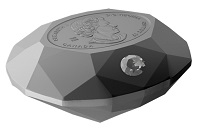
Face value: 50 dollars … Composition: 99.99% pure silver; Mintage: 850; Finish: Matte Proof; Weight: 93.31 g; Diameter: 36.3 x 29.7 x 21.2 mm; Edge: serrated; Artist: The Royal Canadian Mint (reverse), Susanna Blunt (obverse); Packaging: Custom capsule in black clamshell case with certificates of authenticity from Mint and CrossWorks Manufacturing.
DID YOU KNOW? … ***Likened to a “squashed” round brilliant (due to its elongated shape), an oval cut diamond often appears larger than its actual carat weight. ***While oval-shaped diamonds have existed for centuries, the modern oval diamond cut was only developed in the mid-20th century. Many consider its elongated form to represent the longevity of a relationship.
Your coin’s unique shape and multi-faceted design are an exact reproduction of a patented trademark diamond cut from Cross works Manufacturing, as seen on Forever mark Black Label diamonds. Embedded on one of the crown main facets, the 0.23 ct. Forever mark Black Label Oval Diamond—inspired this coin’s shape. The year “2023” is engraved on another crown main facet, while the word “CANADA”, the denomination of “50 DOLLARS” and the effigy of Queen Elizabeth II by Susanna Blunt appear on the largest facet (the table). The obverse also bears a special marking that includes four pearls symbolizing the four effigies that have graced Canadian coins and the double date of her reign.


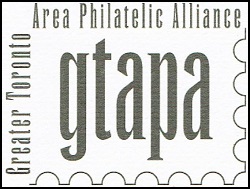
www.gtapa.org
The GTAPA is committed to promote and stimulate
the art of philately to all ages for fun,
culture, education, and friendship.


